
Should kids act to stop bullying, or should they leave it up to adults?
- Subject:
- English Language Arts
- Material Type:
- Homework/Assignment
- Author:
- Kristin Robinson
- Date Added:
- 01/03/2020
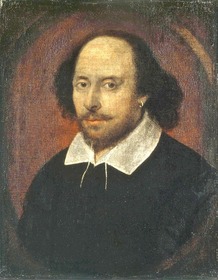

Should kids act to stop bullying, or should they leave it up to adults?

Should kids act to stop bullying, or should they leave it up to adults?

In this problem-based learning module, students will be asked to brainstorm ideas and think innovatively both independently and collaboratively in addressing a real-world problem that is relevant to their daily lives and health. Are students aware of their calorie intake and how it affects their overall health? Students will investigate the calories consumed in a typical day and how much physical activity is needed to stay healthy and fit. Students/teams will be encouraged to use the internet for research purposes in their design phase. Students will utilize various online platforms to design an infographic that can be shared with relevant individuals in the community and others in the school building
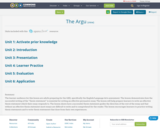
The learner-audience for this lesson are adults preparing for the GED, specifically the English/Language Arts assessment. The lesson demonstrates how the successful writing of the “thesis-statement” is essential for writing an effective persuasive essay. The lesson will help prepare learners to write an effective thesis statement which their essay responds to. The lesson shows how a successful thesis statement guides the direction of the rest of the essay and that without an effective thesis statement most essays are difficult to write and to comprehend for the reader. The lesson encourages learners to practice writing thesis statements and to write thesis statements that draw from their own experiences.
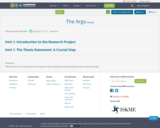
This resource is to introduce the writing of a thesis statement and introduction for a research essay.
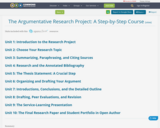
This resource is designed to walk students through the process of completing a research project in any field of study. It covers the earliest stages of brainstorming and discussing, continues through researching and compiling sources; writing, documenting, revising, and polishing a paper; and finally presenting the research topic to a wider audience in a professional manner. The focus is on MLA format, though the course could be modified for other formats.
The first unit is an introduction to the project. It asks students to draw on knowledge of issues affecting their own community and world to help generate discussion that could eventually lead to a research topic.

This video goes over the basics of a 5-paragraph argumentative paper, including the rebuttal. There are examples for each paragraph (introduction + thesis, body paragraphs, rebuttal paragraph, and conclusion).
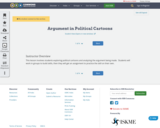
This lesson involves students exploring political cartoons and analyzing the argument being made. Students will work in groups to build skills, then they will get an assignment to practice the skill on their own.
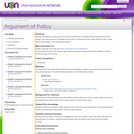
Students will discover a policy within their school or district that is important to them and that they'd like to change. They will conduct an investigation of the policy in question and write a letter with their claim, results, and recommendation to the appropriate audience.
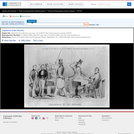
A dramatic portrayal, clearly biased toward the northern point of view, of an incident in Congress which inflamed sectional passions in 1856. The artist recreates the May 22 attack and severe beating of Massachusetts senator Charles Sumner by Representative Preston S. Brooks of South Carolina. Brooks's actions were provoked by Sumner's insulting public remarks against his cousin, Senator Andrew Pickens Butler, and against Illinois senator Stephen A. Douglas, delivered in the Senate two days earlier. The print shows an enraged Brooks (right) standing over the seated Sumner in the Senate chamber, about to land on him a heavy blow of his cane. The unsuspecting Sumner sits writing at his desk. At left is another group. Brooks's fellow South Carolinian Representative Lawrence M. Keitt stands in the center, raising his own cane menacingly to stay possible intervention by the other legislators present. Clearly no help for Sumner is forthcoming. Behind Keitt's back, concealed in his left hand, Keitt holds a pistol. In the foreground are Georgia senator Robert Toombs (far left) and Illinois senator Stephen A. Douglas (hands in pockets) looking vindicated by the event. Behind them elderly Kentucky senator John J. Crittenden is restrained by a fifth, unidentified man. Above the scene is a quote from Henry Ward Beecher's May 31 speech at a Sumner rally in New York, where he proclaimed, "The symbol of the North is the pen; the symbol of the South is the bludgeon." David Tatham attributes the print to the Bufford shop, and suggests that the Library's copy of the print, the only known example, may have been a trial impression, and that the print may not actually have been released. The attribution to Homer was first made by Milton Kaplan.|Probably printed by John H. Bufford, Boston.|Signed with monogram: WH (Winslow Homer).|Title appears as it is written on the item.|Tatham, "Pictorial Responses to the Caning of Senator Sumner," p. 15-16.|Forms part of: American cartoon print filing series (Library of Congress)|Published in: American political prints, 1766-1876 / Bernard F. Reilly. Boston : G.K. Hall, 1991, entry 1856-1.|Exhibited: American Treasures of the Library of Congress.
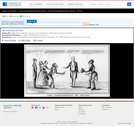
Signed in stone: J. Cn.|Title appears as it is written on the item.|Forms part of: American cartoon print filing series (Library of Congress)
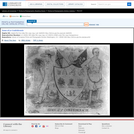
A small card bearing a vitriolic indictment of the Confederacy. The artist particularly attacks the the institution of slavery, the foundation of Southern economy. A large shield is flanked by two figures: a planter (left) and a slave. The planter wears spurs and a broad-brimmed hat and smokes a cigar. The slave is clad only in breeches, and his hands are manacled. Above the shield are two crossed flags, the Confederate flag and one bearing a skull and crossbones and the number 290. Between the flags are a rooster and a streamer with the motto "servitudo esto perpetua." On the shield are images associated with the South: a mint julep, a bottle of "Old Rye," a pistol and dagger, a whip and manacles, cotton, tobacco, and sugar plants, and slaves hoeing. In the background left, dominated by the palmetto tree of South Carolina, three planters, one holding a whip, play cards at a table. Beyond, two men duel with pistols. On the right, a female slave is auctioned as two slave children stand by and a black woman watches from a cabin doorway.|G.H. Heap Inv. [i.e., published].|H.H. Tilley Del. et Sc.|Title appears as it is written on the item.|Forms part of: American cartoon print filing series (Library of Congress)|Published in: American political prints, 1766-1876 / Bernard F. Reilly. Boston : G.K. Hall, 1991, entry 1862-13.
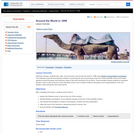
Students use Library of Congress primary sources to plan, take, and document a trip around the world in 1896.

This lesson is aimed at adults who have experienced an interruption of their education for whatever reason. The purpose is to develop reading and writing skills while learning how to express their opinions regarding an art form.
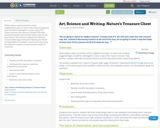
While taking a walk around their school, neighborhood, park, or nature trail, students (suggested ages 3-8) will be challenged to create a map of the 'nature treasures' they discover. Students will make thumbnail sketches and brief descriptive notes of what they observe.
This activity is adapted from "Nature's Treasure Map" (page 34) found in "Opening the World Through Nature Journaling" a curriculum by Jack Laws, that integrates science, art and writing for grade 4-8 classroom.
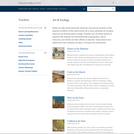
Artists are often particularly keen observers and precise recorders of the physical conditions of the natural world. As a result, paintings can be good resources for learning about ecology. Teachers can use this lesson to examine with students the interrelationship of geography, natural resources, and climate and their effects on daily life. It also addresses the roles students can take in caring for the environment. Students will look at paintings that represent cool temperate, warm temperate, and tropical climates.
In this lesson students will: Identify natural resources found in particular geographic areas; Discuss ways in which climate, natural resources, and geography affect daily life; Apply critical-thinking skills to consider the various choices artists have made in their representations of the natural world; Make personal connections to the theme by discussing ways they can be environmental stewards; Identify natural resources found in particular geographic areas; Discuss ways in which climate, natural resources, and geography affect daily life; Apply critical-thinking skills to consider the various choices artists have made in their representations of the natural world; Make personal connections to the theme by discussing ways they can be environmental stewards.
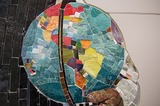
This unit explores the various ways information and ideas about climate change are presented through a variety of media. This includes the evaluation of social media posts, research into climate change issues, and an exploration of contemporary art and artists. This was designed and taught in an honors 9th grade English Language Arts Classroom by Dr. Tavia Quaid in response to student interest in climate change and to reinforce key information literacy skills.

These active process-oriented lessons focus on concepts of line direction and type, organic shape, 3-D form, real and implied texture, secondary color, and principles of composition. Literacy-infused lessons explore text direction/spacing, observation, description, and story elements through drawing, painting, collage, clay modeling and printmaking.
The K-6 lesson handbooks were originally produced for the Lake Washington School District with grants from 4culture and ArtsWA. Encourage your colleagues, other schools, and organizations to use these materials for non-commercial, educational purposes at no cost by downloading their own copy at: http://artsedwashington.org/portfolio-items/alic-2
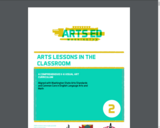
A broad range of art is created using concepts of contour and line type, abstraction, color palette, 3-D form, and positive and negative space. Students make both realistic and abstract drawings, relief prints, paintings, and paper sculptures. Literacy-infused lessons include making sketch/journal entries, inventing clay characters and illustrating stories and poems in collage.
The K-6 lesson handbooks were originally produced for the Lake Washington School District with grants from 4culture and ArtsWA. Encourage your colleagues, other schools, and organizations to use these materials for non-commercial, educational purposes at no cost by downloading their own copy at: http://artsedwashington.org/portfolio-items/alic-2
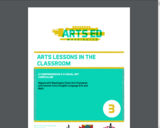
Fundamental concepts and skills are applied in new ways. Line is used to invent characters in monotype prints and show figures in action within drawings and wire sculptures. Elements of scale, horizon, overlapping, shape and texture in painting and printmaking reference specific time and place for settings. Students also visualize and write in response to art.
The K-6 lesson handbooks were originally produced for the Lake Washington School District with grants from 4culture and ArtsWA. Encourage your colleagues, other schools, and organizations to use these materials for non-commercial, educational purposes at no cost by downloading their own copy at: http://artsedwashington.org/portfolio-items/alic-2